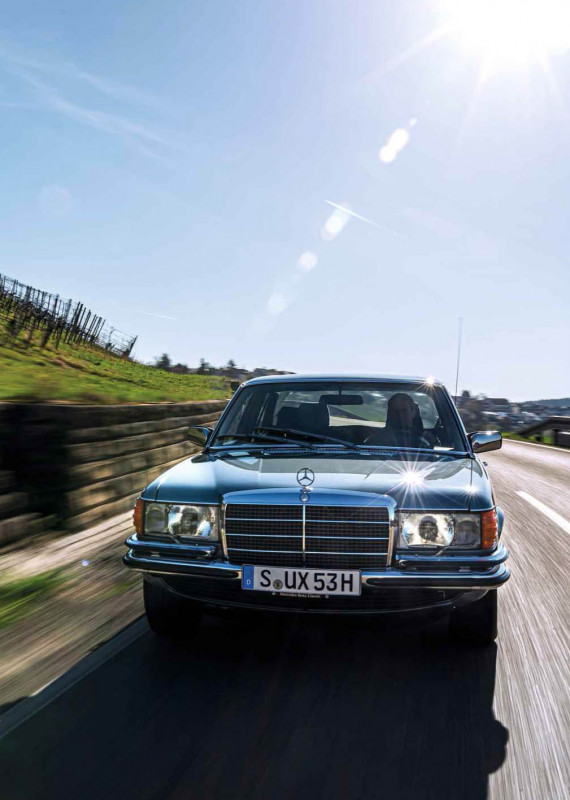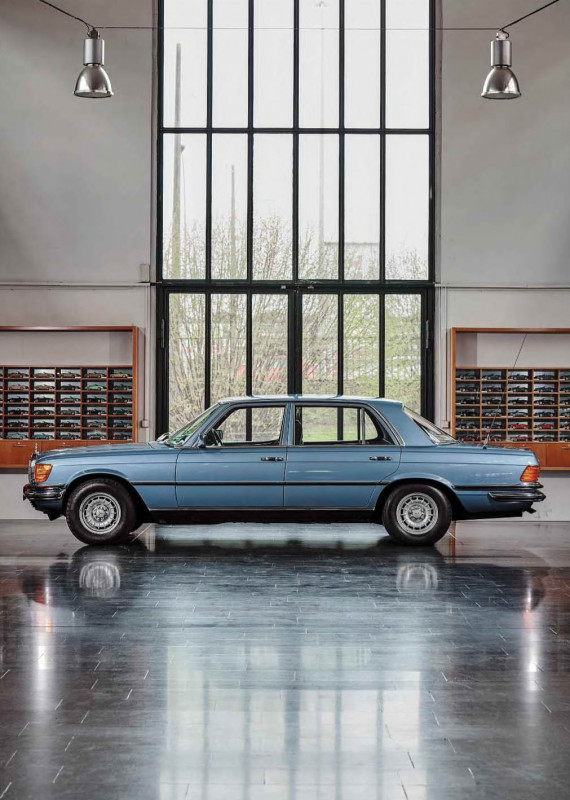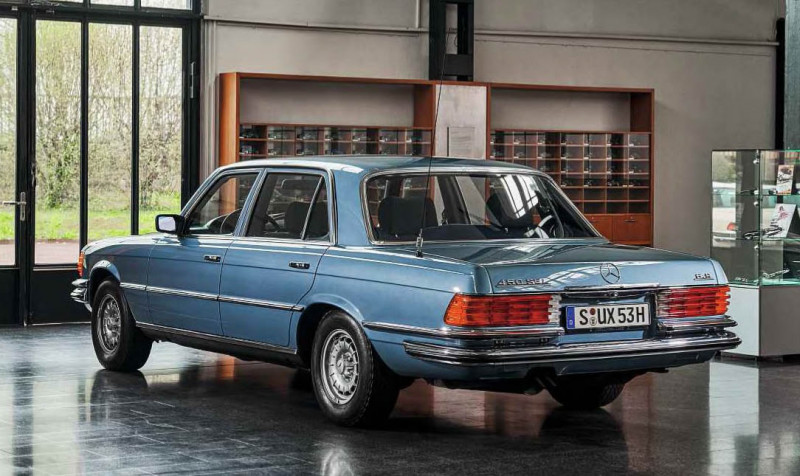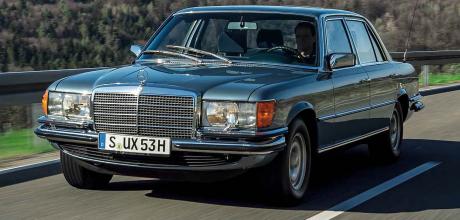1977 Mercedes-Benz 450SEL 6.9 W116
Five decades have elapsed since Mercedes-Benz launched the first S-Class. Glen Waddington drives the greatest of its type: the W116 450SEL 6.9.
Photography Mercedes-Benz
MERCEDES-BENZ 450SEL 6.9 W116 50 years of the S-Class. We drive the best
Piling along. Not really wafting, though were certainly surging between the bends. Yes, piling along feels about right. Long, straight French roads close to Le Mans, gently undulating countryside, old Routes Nationales, the kind of scenario for which Citroen developed the DS. Which is worth mentioning, as theMercedes-Benz 450SEL 6.9 W116 has very similar suspension, and possesses something the DS always lacked: suitable motive power. As Jay Leno said in the last issue of Octane: ‘A luxury car with a four-cylinder engine and 100 horsepower is going to be a tough sell.’

And this S-class has a V8. A very big V8.
'IT DASHED THROUGH THE MARKETPLACE AND DOWN A FAST FOUR-MILE STRAIGHT - WHILE THE ATTENTION OF LOCAL POLICE WAS ELSEWHERE’
It also represents the first of a new breed, one still going 50 years later: the Sonderklasse (or ‘Special Class’) is now in its seventh generation. Predecessors such as the ‘Ponton’ saloon and the ‘Pintail’ had been available with six-cylinder engines, and its immediate predecessor had even come as an SEL (Sedan Enspritzung Lang or ‘fuel-injected long-wheelbase saloon’), but this was a luxury car for the modern age. And, while there was a 2.8-litre straight-six footing the range, the 350 and 450 V8s clearly had their sights set on the USA market.

The full-fat 6.9 was still three years away when the W116 (the S-Class’s internal designation) was launched to the press in Spain on 25 September 1972 — just ahead of its public appearance at October’s Paris motor show. And that order is unusual. Mercedes-Benz’s publicity man Dirk Strassi had decided two years previously to release the still-secret S-Class to invited journalists on the Costa Brava, all staying at the exclusive Cap Sa Sal hotel while the sun still shone.
‘Dirk the Merc’, as he was known, had studied Spanish in Barcelona and knew the area well. He combined his love of the Iberian peninsula, its weather and its luxury accommodation with Teutonic thoroughness, organising with the Governor of Gerona to resurface a ten-mile stretch of road between Agua Blava and Palafrugell in time for the launch. There, between Barcelona and the French border, the journalists tested the six-cylinder 280, the V8-powered 350SE and a few pre-production 450s on uprated suspension — as a clue to what the S-Class could be capable of.

The ‘circuit’ included sweeping esses and fast comers; it dashed through the marketplace of Palafrugell and down a fast four-mile straight before hooking back through the bends to Agua Blava — all while the attention of local police was elsewhere. And thus it became known that here was a new luxury saloon that was capable of a decent turn of speed even over challenging roads. And that’s before we factor in the 6.9.
Of course, Mercedes-Benz was pretty confident in its new car’s abilities. It had been tested extensively on its engineers’ favourite road route: the so-called ‘Friedrichsruhe test circuit’, around 50 miles from Stuttgart. Developed during the 1960s, the route was mapped by Mercedes engineers and measured exactly 34.5km in length. It offered a range of surfaces and conditions to test and tune a car’s chassis, and two auxiliary shorter circuits (of 18.9 and 26.5km) for precise testing conditions without the need to drive the full lap.
There the Mercedes test drivers could generate data and implement their improvements, ready for immediate assessment. The same route was maintained year after year and the test engineers knew every inch of it, so they could recognise the exact degree of improvement they were achieving. The W116 was tested there; the experimental C111 had been, too. It lent the S-Class its double-wishbone front suspension, complete with groundbreaking safety-inspired zero-offset steering and anti-dive control.
In fact the W116 made extensive use of the knowledge gained from the Clll and Mercedes’ series of Experimental Safety Vehicles. Particularly significant was the addition in 1978 of antilock brakes, which had been co-developed with Bosch: it was the first road car to feature that system. The W116 built on the innovations of its predecessors, too, such as the safety cell and crumple zones, burst-proof locks, and standardised disc brakes and seatbelts of the 1960s W111/112 generation. It featured an even more stable passenger cell, with a stiffened roof structure, high- strength pillars and reinforced doors — capable of withstanding an offset collision with a concrete block. It was the first car thus tested.
The fuel tank was re-located above the rear axle for protection against collisions and, inside, a heavily padded dashboard, deformable or concealed switchgear and a new four-spoke steering wheel with impact absorber made it a more comfortable environment in which to experience the worst-case-scenario when it finally let go of the road. Special A-pillar channels served as gutters, aiding forward visibility in rain and helping to keep the side windows clear. There were wrap-around indicators, visible from the side, and the rear light clusters were fluted, to keep them free of grime. This new approach to safety helped the 450SE (launched a little later than the 280 and 350) win the coveted European Car of the Year award in 1974.
The 450SEL 6.9 arrived in May 1975, built on a separate assembly line using only the long-wheelbase W116 body. Its handbuilt cast-iron V8 was a bigger version of that used in the 600 limo and the old Erich Waxenberger-developed 300SEL 6.3 hot rod, notable for its Bosch K-Jetronic electromechanical fuel injection, forged crankshaft, conrods and pistons, and dry-sump lubrication. Huge, powerful and yet understressed, it was easy to service and long-lived, and the strength of every single example was proven in bench-testing, a process that took longer than four hours, including 40 minutes being redlined. Yup, this was an engine you could thrash.
As you might expect, it delivered its power (286bhp) and (more impressive) its 405lb ft of torque to the rear wheels, via a limited-slip dift' from a three-speed automatic gearbox that was unique to the 6.9. And while Mercedes-Benz already had form with air suspension, the 6.9 was its first car to be fitted with a Citroen-style hydropneumatic self-levelling system. It employed fluid-filled struts and nitrogen-filled accumulators, pressurised by a hydraulic pump driven by the engines timing chain. Every 6.9 was fitted with rubber emergency dampers that allowed the car to be driven if the hydraulics failed. You can raise the ride height by 50mm via a push-pull knob, on the dash below the speedo.
The press certainly liked it. In its June 1975 issue, Car said: A car of such speed and weight must have demonstrably good roadholding and handling, and this one is no disappointment in anything from a hairpin to a three-figure-bend.’
A couple of years later, Car challenged the big Merc against the Rolls-Royce Silver Shadow, Jaguar XJ12 and Cadillacs Seville, the prize being the accolade of ‘best car in the world’. Its tester Ronald ‘Steady’ Barker called it ‘a genuine four-door four-seater hard-topped air-conditioned racing car’. Meanwhile, bearing in mind the potential market for such expensive saloons, the magazine sought the opinion of John Hatton, personal chauffeur of the TV and radio personality (and known car enthusiast) Noel Edmonds. A driver’s car’ but ‘not chauffeur’s car’, he said, and admitted to feeling ‘frustrated’ and seeking solace in the beautifully laid-out controls and waiting for the chance to have it and a decent country road all to yourself one day’.
The 6.9 was a seriously exclusive car, delayed in its introduction so that it wouldn’t be sunk by the Oil Crisis. Only 7380 were built, out of a total of nearly half-a-million W116s during its seven-year career, and its closest rival on price was the Silver Shadow: it cost twice as much as the entry-level 280SE W116. That V8 was the largest fitted to a European production car since World War Two, and even Mercedes admitted at the time that ‘an engine with a displacement of 6.9 litres was difficult to sell’. Ironic, given Leno’s remark.
The 6.9 made a memorable appearance in the John Frankenheimer chase caper Ronin and was the car used by Claude Lelouch to film Cetait un Rendez-vous — thought the soundtrack was dubbed over with that of a Ferrari V12. Celebrities loved them, among them Frank Sinatra and F1 drivers Emerson Fittipaldi and James Hunt. Hunt hadn’t forked out for alloys and his went without hubcaps, so it rode on black steelies and was often to be seen parked kerbside near his Surrey home. It was brown. How to make a cool car cooler.
The one in these pictures has been in the Mercedes-Benz Museum’s collection since the early 1990s. It used to belong to the fleet of an industry association, so has been kept well-maintained all its life. I suspect the paint isn’t that applied at the factory all those years ago, but I’m assured that the panels and brightwork outside and the walnut fillets and ribbed velour trim within are original. Which makes its odometer reading of 647,736km utterly astonishing. That’s more than 400,000 miles!
The door swings shut with an undamped and resoundingly mechanical finality that’s a world away from the rubbery thud of today’s equivalent and extraordinarily satisfying in its own right. You bounce on the big, sprung seat, surveying surroundings that are clad largely in slabs of moulded plastic. It’s solid, efficient, logical, spacious, airy: a very different interpretation of luxury from that of a Rolls-Royce, or even the attempt on that made by Jaguar. We won’t bother mentioning the Cadillac here.
Twist the key and that V8 rocks the car gently; Merc’s hoof-upended- on-a-map-of-the-Mississippi transmission selector works crisply. Broad steering wheel, big sweeps of lock to manoeuvre, lots of throttle pedal travel, but once you get beyond crawling pace it begins to make sense: not the soft, silent type, more the swiftly effective sort. The hydro suspension pads out troughs in the tarmac, and though the 6.9 is not immune to roll or body movement, it is endowed with a sense of indomitable stability.
By the standards of its day this is a huge car, but today a slip over 5m in length is not so unusual, it’s little wider than many hatchbacks and its weight is well shy of two tonnes — there’s been a distinct lack of progress in that respect in five decades. Hold the transmission in second, gun the V8 and you’ll hear it sing, encouragingly. With three long ratios to pull against, it’s no sprinter, but it gains pace with deceptive ease. On an unrestricted Autobahn it would be magnificent, fast and refined but not without feedback: you can place it with confidence and trust those big discs to haul you back when a truck suddenly pulls out. Or you can allow the torque to take over and you’ll slur along, undisturbed by bumps or noise. Just remember what Noel Edmonds’ chap said.
As for Car’s giant test’, it didn’t declare the Merc to be the ‘best car in the world’. Nor the Rolls that inspired the idea. No, the XJ12 won, perhaps deservedly so, though few cars could ever put the 6.9 in the shade. And I’d love to know how that Jaguar would fare today, with 400k on the clock.
Clockwise, from above Huge in its day, now relatively slim by super-saloon standards; very much at home on its Spanish Costa Brava launch; pioneering use of antilock brakes demonstrated here.
Facing page and above right Clock this in your rear-view mirror on the Autobahn and you'll move over sharpish; that badge is all-important
TECHNICAL DATA 1977 Mercedes-Benz 450SEL 6.9W116
- Engine 6834cc dry-sump V8, OHC per bank, Bosch electromechanical fuel injection
- Max Power 286bhp @ 4250rpm
- Max Torque 405lb ft @ 3000rpm
- Transmission Three-speed automatic, rear-wheel drive, limited-slip differential
- Steering Recirculating ball, power-assisted
- Suspension Front: double wishbones, self-levelling hydropneumatic spring/damper units. Rear: semi-trailing arms, self-levelling hydropneumatic spring/damper units
- Brakes Discs
- Weight 1843kg
- Top speed 140mph
- 0-60mph 7.3sec


